If you are an Android power user, you must know the Android OS is customizable. The layout and function of an Android can be changed by installing what is called a Custom ROM. Custom ROM will provide you with a variety of interesting features on your Android. For those who find themselves dissatisfied with its original setting, this is a perfect solution. Those who also prefer to make their phone a bit more original and less bloatware will benefit from flashing custom ROM’s on their Android, as there are so many options to choose from you will be sure to find one that suits you. But before installing anything on your phone, you’ll want to understand what it is.
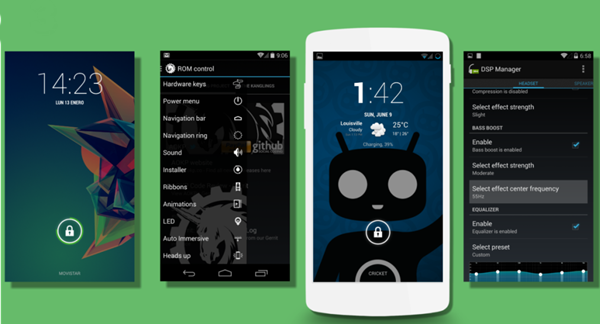
What is a Custom ROM?
Preparing Your Phone for Installation, and Installing Custom Recovery TWRP
Flashing a Custom ROM Using TWSP Recovery
Upon purchasing an Android phone or tablet, you see it installed with what is called a ‘stock ROM’.
Stock ROM is the basic in functionality and design of your device. This is what the manufacturers have decided is the stock standard firmware for these phones or devices. While some people may be happy with this, it is limited in its functions. Those who want to change the way they view and use their device will want to look at custom ROM’s.
A custom ROM, or any ROM, is talked about in relation the firmware of a phone. This firmware is what compiles your phones capabilities as well as its on-screen appearance. Installing custom ROM’s will change this, and can do so in a variety of ways.
Custom ROM’s are developed and worked on by those who enjoy doing so. These could be fans of the Android brand, people interested in graphic designing, and a range of other possibilities. A ROM is an open source. Creating your own custom one means re-editing the original Android code and putting your own touches on it through screen features or technical features. This changes the functionality and appearance of a device once it is installed.

Seeing as it is free to make, and as most creators of Custom ROM’s are fans of Android, they are free to download from LineageOS or Android forums such as XDA custom ROM central. They are available for Android phone and tablets, but for the purpose here we will be discussing their uses and practicalities of installation on an Android phone.
Once you have decided to modify your Android, you want to take a few steps before installing a Custom ROM to ensure your phone is safe. To do this, a custom recovery (TWRP or CWM) is the most important thing to install. Custom recovery will allow you to load Custom ROM’s to your phone, but will also back up your device in case of any mishaps.
TWRP is considered the best custom recovery people. This is because the TWRP function supports most phones and can also handle more complicated tasks on your phone. For this reason, it should be installed on the phone of any user who wants to experiment with Custom ROM’s.
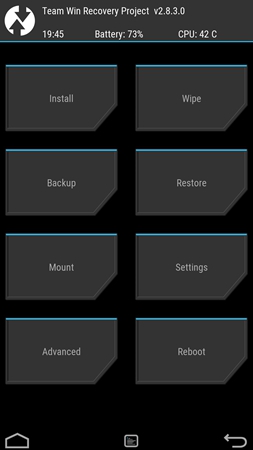
Before you download TWRP, your phone must be rooted. Being rooted means being able to tweak the files in your phone; your data, your system. There are a number of methods in being able to do this.
Some apps will assist you in rooting your phone, for example, the ‘KingoRoot’ or ‘iRoot’ app. See more details on how to root an Android device.
As well as being rooted, the bootloader of your phone must also be unlocked. Bootloader is the software that powers up Android when you turn on your device. Before you unlock the bootloader, the bootloader will stop your phone from booting up with a custom ROM.
Using ‘KingoRoot’ or ‘iRoot’ Auto Root will assist in both these activities. It unlocks your bootloader and also roots your phone. But if you root your phone in other ways, don’t forget to check if the bootloader is unlocked.
Once your phone is rooted and the bootloader is unlocked, you are ready to install custom recovery TWRP and begin flashing Custom ROM’s on your Android.
First, install the official TWRP App from the Google Play store. Once in the app, accept all terms of service, and allow the app root access.
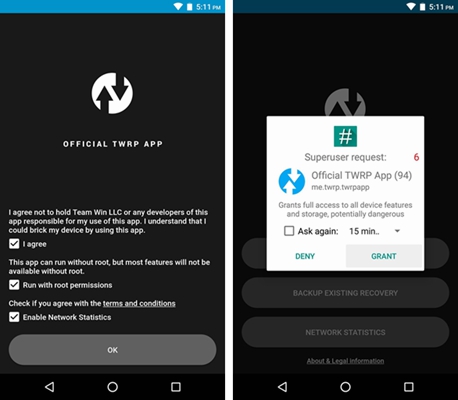
You should also backup the recovery you initially have. This can be done on the TWRP app’s main menu.
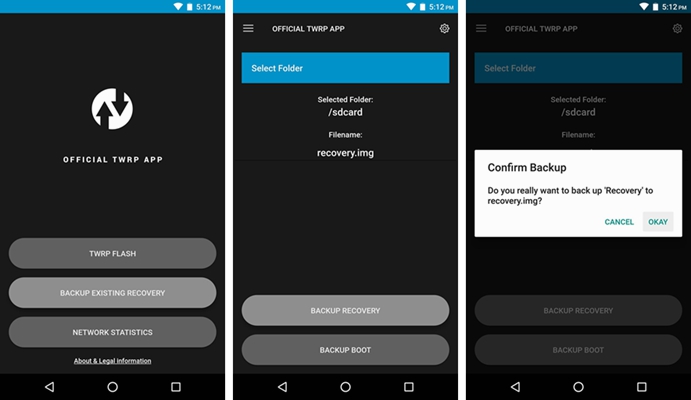
After this, you can download the actual TWRP. This is done by choosing TWRP Flash from the main menu and then selecting your device. Once you are given the option of which version of TWRP to download, choose the latest.
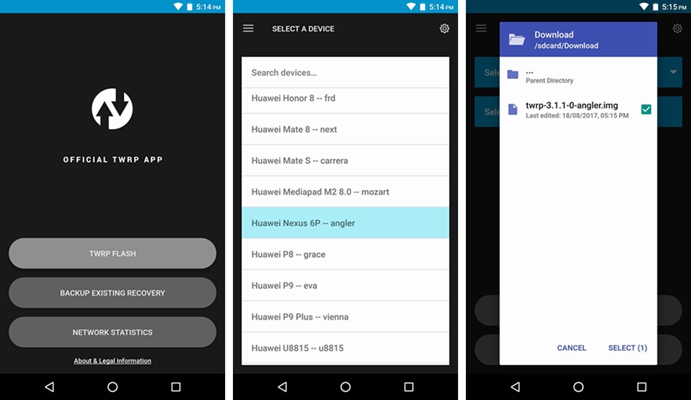
When this is downloaded, you can go back to the app and tap ‘select a file to flash’. This is done in the downloads folder.
Tap ‘Flash to Recovery’ and you will shortly get a confirmation message. TWRP is now installed.
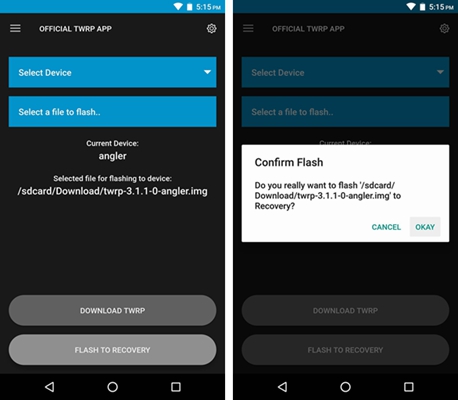
Make sure to backup your phone before installing custom ROM’s, just in case anything goes wrong.
You can now start flashing custom ROM’s. First, download a custom ROM to your device, where it will go into device’s internal storage.
Next, boot your phone into recovery mode. Power off your phone, then press and hold the Vol Down + Power button (on Samsung device, press and hold the Vol Down + Home/Bixby + Power button) for about 10 seconds. Once you boot into TWRP recovery, you will see below screen. See detail steps on how to enter recovery mode.

From the TWRP app, you can select an option called ‘Install’. Here you can select the custom ROM you previously downloaded. After confirming the ROM will begin its own installation.
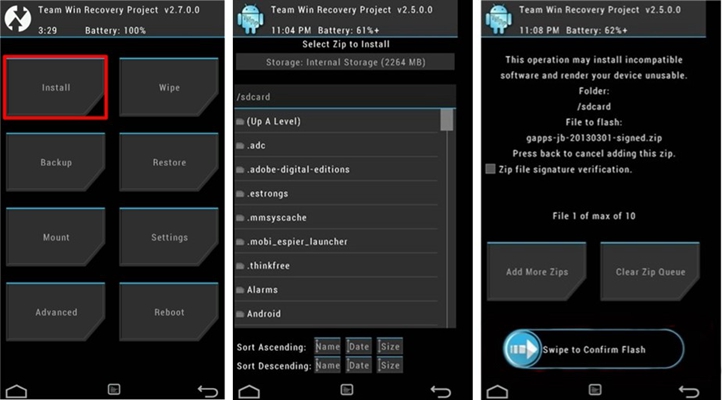
After this, tap ‘wipe’ and select ‘Dalvik Cache’ and ‘cache’, then swipe to clear the cache.
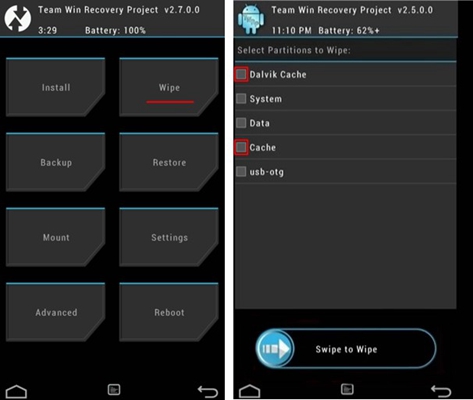
Finally ‘reboot system’. This successfully completes the installation of a custom ROM on your Android phone.
Patience is key through the downloading and installation process. Waiting through downloads is painful, we know, but it will pay off in the end when your custom ROM’s are efficiently and successfully downloaded once your system reboots.
By following these instructions you will be able to try out a variety of Custom ROM’s on your Android. Seeing as there are so many available, and so many still being made, this can provide hours of entertainment. You may even feel spoilt for choice.
It is important to know that doing these things to your Android can potentially change it forever, and can even cause a problem. One issue, called ‘bricking’, does not occur often, but makes your phone inoperable. Be aware of these risks as you follow the steps. Most phones should be okay and still operate just as they were when they were purchased.